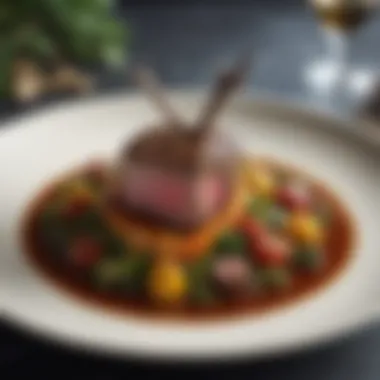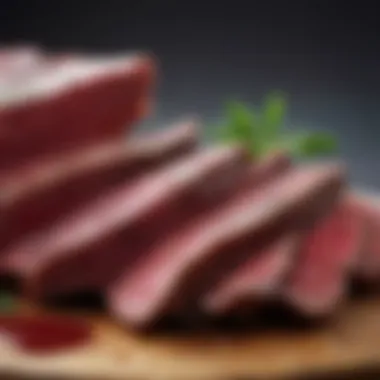Exploring New Zealand Venison: Unique Culinary Insights


Intro
New Zealand venison is renowned for its delicate flavor and superb quality. The mixture of well-managed farming practices and natural grazing conditions grants this meat its unique characteristics. This section of the article will explore how the distinct environment contributes to venison's culinary appeal. Attention will also focus on health benefits, methods of preparation, and an assortment of delectable recipes aimed at integrating venison into both everyday meals and special celebratory occasions. As we navigate this guide, we aim to provide culinary enthusiasts with valuable insights that enhance their appreciation for one of nature's high-quality meats.
Recipe Overview
Savory New Zealand Venison Stew
- Portions: Serves 4
- Time Required: 40 minutes prep, 2 hours cook
- Difficulty Level: Medium
- Main Ingredients: New Zealand venison, carrots, potatoes, onions, garlic, and red wine.
The Savory New Zealand Venison Stew is a hearty dish that encapsulates the rich venison flavor. Ideal for long dinners or gatherings, it showcases the natural qualities of the meat while also being flexible enough for home cooks to adapt with seasonal ingredients.
Step-by-Step Instructions
Preparing the Ingredients
- Venison: Cut the venison into bite-sized pieces. You may want to trim any excess fat for a lighter stew.
- Vegetables: Chop the onions and garlic. Dice the potatoes and slice the carrots into medallions.
- Herbs: Fresh herbs work well. Consider using thyme, rosemary, or bay leaves to enhance flavor.
Cooking the Dish
- In a large pot, heat oil over medium-high heat.
- Brown the venison pieces for about 5-7 minutes. This step locks in the flavors.
- Add the garlic and onions, cooking for another 2 minutes.
- Incorporate the carrots and potatoes. Stir to evenly mix ingredients.
- Pour in red wine and scrape off any bits stuck on the bottom for added flavor.
- Add in enough water or broth to cover the ingredients.
- Bring to a boil, then lower the heat to let it simmer for about 1.5 hours or until the venison is tender.
- Season according to taste towards the end of cooking.
Time-Saving Strategies
- Utilizing pre-chopped vegetables can significantly cut down on preparation time.
- Cook in a slow cooker for an easy, set-and-forget option.
Nutritional Information
- Total Calories: Approximately 380 per portion
- Protein: ~50g
- Fats: ~12g
- Carbohydrates: ~30g
New Zealand venison is high in protein and iron, which supports maintaining fitness levels and promoting immune health. Additionally, the nutritional profile is favorably low in saturated fat, attracting those looking for healthier meat options.
Quick Cooking Tips
- Kitchen Gadgets: Consider using a slow cooker for a tender result, or an Instant Pot for fast cooking while maintaining flavor.
- Multitasking: While the stew cooks, prep other meals or side dishes to serve alongside.
- Healthier Alternatives: Substitute standard potatoes with sweet potatoes for added nutrients.
Related Recipes & Variations
- Explore venison meatloaf as another comforting option that keeps well for leftovers.
- Consider making venison tacos using cut-up venison alongside typical toppings for a different twist.
- For those with gluten intolerances, ensure ingredients are certified and opt for gluten-free substitutes.
Sharing your takes on the Savory New Zealand Venison Stew can inspire others. Additional feedback may lead to even more revelatory methods to incorporate venison into daily cooking.
Prelude to New Zealand Venison
New Zealand venison has gained a reputation as a premium choice among nutrition-conscious eaters and culinary innovators alike. The significance of New Zealand's mountain ranges and lush pastures equals the sleek, nutrient-dense meat that garners food enthusiasts’ attention worldwide. Understanding New Zealand venison’s value helps in making informed choices in the kitchen. It also sheds light on its potential in various cuisines.
Defining Venison and Its Origins
Venison is defined as the meat derived from deer. While it commonly refers to larger deer varieties, it can also include other species like elk and moose. Its origin is steeped in history, with hunting cultures across the globe leading to various preparation methods and seasonal harvests.
Traditionally, venison was an essential part of diet for early civilizations. Over time, its amount declined somewhat, but it is experiencing a robust resurgence today. This reinvented interest can often be attributed to consumers seeking game meat options that provide depth and character, both on the plate and in nutrition.
The Significance of New Zealand in the Venison Market


New Zealand plays a pivotal role in the global venison market. This country produces some of the world’s most sought-after venison, particularly from species such as the Red and Second-Nature deer. New Zealand's unique climate and geographical features act as a natural barrier, making it an opportune environment for farming deer.
Here are a few points highlighting New Zealand venison's market impact:
- Quality Production: Farms often employ humane and sustainable practices. These methods promote the growth of healthy deer that deliver high-quality meat.
- Export Leader: New Zealand is a key player in venison exports. The country's venison is shipped to various markets worldwide, including Europe and North America.
- Growing Demand: As global dietary preferences shift and health consciousness rise, the interest in leaner meats like venison increases. It brings a balance of culinary artistry and nutritious offerings.
The appreciation for New Zealand venison extends beyond its flavor; it embodies sustainability and health-conscious consumption in an increasingly aware market.
Unique Characteristics of New Zealand Venison
New Zealand venison is recognized for its unique characteristics that set it apart from venison produced in other regions. Understanding these traits is vital for culinary enthusiasts as they create dishes that highlight venison’s distinct flavors and benefits. This knowledge enhances the cooking experience and promotes better ingredient selection and preparation techniques, ultimately leading to more satisfying meals.
Flavor Profile and Texture
One major aspect to appreciate about New Zealand venison is its exceptional flavor profile. The meat is known for its distinct, rich taste that can vary between species, notably the red deer and the wapiti. Red deer venison offers a slightly sweet, robust flavor, while wapiti tends to have a milder taste.
In terms of texture, New Zealand venison presents a lean quality. The meat is tender yet firm, allowing for versatile culinary approaches. This leanness contributes to a better mouthfeel and ensures that the meat can absorb marinades and seasonings well, enhancing taste with two additional aspects:
- Moisture retention during cooking: New Zealand venison possesses natural juiciness, which helps retain moisture even through various cooking methods. This ability makes it ideal for roasting or grilling.
- Adapts well to various cooking techniques: Due to its tenderness, New Zealand venison can withstand quicker cooking methods, including searing or stir-frying. Though proper cooking time is crucial to prevent overcooking, the results can yield exquisite meals that charm any palate.
Understanding this flavor profile and texture aspect is essential for any masterful preparation of venison dishes.
Nutritional Benefits and Health Implications
Apart from its culinary appeal, New Zealand venison is celebrated for its impressive nutritional profile. This meat is not only flavorful but also packed with health advantages, attracting many who are focused on overall wellness.
Some key aspects include:
- Low in fat: Because New Zealand venison is naturally lean, it provides a low-fat alternative to other red meats. This quality is often sought out in health-conscious diets, easing concerns about saturated fats.
- High protein content: It is an excellent source of protein, which is essential for muscle building and repair.
- Rich in vitamins and minerals: New Zealand venison contains various important nutrients such as B vitamins, iron, and zinc, contributing significantly to a balanced diet.
Notably, opt for grass-fed sources of New Zealand venison, as they are linked to even higher nutrient density than grains or feedlot options, promoting sustainibility.
However, even with all these benefits, it is prudent to consider preparation methods. Pairing venison with whole grains and plenty of vegetables can provide even more health benefits and balance. Emphasizing nutrient-rich side dishes complements the inherently lean and protein-heavy venison.
Through recognizing these parameters surrounding New Zealand venison—both in flavor and nutrition—chefs can improve their techniques while also promoting healthier eating habits.
Farming Practices and Sustainability
Farming practices and sustainability play a significant role in determining the quality and availability of New Zealand venison. The methods used to raise these animals directly affect their health and the quality of the meat. Additionally, how these farming practices are structured impacts the environmental footprint of production, contributing either positively or negatively to New Zealand’s ecosystems.
High-quality venison comes from animals reared in environments that allow natural behaviors and healthy diets. In New Zealand, there is a notable emphasis on sustainable farming practices, making it a leader in the venison market. This devotion to animal welfare and ecological health underscores not just the but also the blessed benefits consumers receive when choosing New Zealand venison as their protein source.
Free-Ranging Versus Farmed Venison
When considering the source of venison, understanding the difference between free-ranging and farmed venison is essential. Free-ranging venison is often harvested from deer in the wild, primarily from regions around the Southern Alps and some forests. This method typically results in leaner meat with robust flavors, stemming from a natural diet and active lifestyle.
Conversely, farmed venison is produced on specialized farms where deer are raised in more controlled environments. While farmed venison can provide predictable supply and quality, some health enthusiasts claim it lacks the rich taste profile of its wild counterpart. Moreover, farmed deer may have different diets, potentially leading to variations in nutrient distributions. Whether wild or farmed, consumers should consider aspects like sourcing and production processes. Each method has its own merits, impacting not only taste and quality but also consumer perception of sustainability and animal rights.
Environmental Considerations in Venison Production
Sustainability and responsible venison production model essential to New Zealand’s reputation. An important aspect of venison farming involves the careful management of the land utilized. Practices that promote regenerative agriculture are preferred, aiming to maintain the health of soil and ecosystems where venison is raised.
A few key points in environmental practices include:


- Land management: Directly affecting deer habitat impact and forage growth can improve not only meat quality but biodiversity.
- Water resources: Effective water usage and management help maintain ecological balance to prevent degradation.
- Biodiversity conservation: Maintaining native plants and promoting diverse microorganism helps create healthier farming ecosystems.
- Waste management: Efforts to minimize waste, including sustainable feed production, are fundamental to limiting negative environmental repercussions.
The delicate balance between production demands and environmental stewardship highlights the distinctive advantage of New Zealand venison. Through applying sustainable methods, producers uphold the integrity of their food systems while offering high-quality, fine meat for culinary enthusiasts.
“New Zealand venison is not just about flavor; it’s about ethical practices that sustain our earth.”
Understanding these factors ensures consumers are as informed as possible when they make decisions about their food. The more we know about farming practices, the better choices we can all make, contributing to healthier diets and a safer planet.
Preparation Techniques for New Zealand Venison
Preparation of New Zealand venison is pivotal in achieving its best potential on the plate. Understanding various preparation techniques enables cooks to optimize the meat's unique characteristics of flavor, tenderness, and health benefits. Mastering these methods leads not just to tastier dishes but also to better overall meal experiences.
Essential Cooking Methods
Roasting
Roasting New Zealand venison is a time-honored technique that allows the meat to retain its moisture and flavor. One of its most appealing aspects is the creation of a savory crust, enhancing the natural taste. It is particularly beneficial for larger cuts of venison, such as the leg or haunch. This method not only requires minimal attention once initiated but also results in a dish suitable for special occasions without excessive effort.
One significant advantage is even cooking, where the heat envelops the meat uniformly, producing a consistent doneness. However, improper timing or temperature can lead to overcooking, which negatively impacts texture. Roasting requires attention to initial seasoning and often benefits from a rest period post-cooking, allowing the juices to redistribute.
Grilling
Grilling is another favored method for preparing venison. This cooking technique introduces a distinct char that adds complexity to the flavor profile. Ideal for steaks or chops, it enhances the meat’s rich, gamey taste, appreciated by many culinary enthusiasts. Grilling provides an excellent option for those looking for quick cooking times while achieving that smoky aroma inherent to this method.
The main characteristic of grilling is its temperature control, often leading to a satisfying crust while keeping the interior juicy. However, the contrast of cooking can be a double-edged sword. Care is needed to avoid rising too high of heat, risking the dried-out outcome and making this preparation technique sometimes tricky, especially for those less familiar with venison.
Braising
Braising is a method that involves both wet and dry heat, essentially cooking the venison slowly and at low temperatures. This technique is particularly beneficial for tougher cuts, making it more tender and flavorful over time. The liquid, added during braising, can make the dish rich and aromatic, creating a sauce that complements the meat beautifully.
A distinctive feature of braising is its flexibility; various spices and aromatics can be used to match personal preferences or seasonal ingredients. However, it does require a significant cooking time, which means planning is crucial. There is also the potential for loss of some unique venison flavors if the initial seasoning is too mild or diluted with the braising liquid.
Marinating and Seasoning Venison
Marinating offers the chance to enhance venison through thoughtful seasoning and additional flavor dimensions. The process involves soaking the meat in a mixture of acids like vinegar or citrus and oils, mixed with herbs and spices. This not only tenderizes the meat but also
Quick and Easy Recipes Using New Zealand Venison
Quick and easy recipes featuring New Zealand venison are not just about saving time; they also enable a diverse array of culinary experiences. This section emphasizes the importance of incorporating venison into meals that are both convenient and satisfying, showcasing its versatility. By adapting venison to simple recipes, home cooks can harness its unique texture and flavor benefits without overwhelming themselves with complicated techniques. Additionally, venison's nutritional profile makes it a smart choice for everyday meals, perfectly balancing health and taste.
Weeknight Venison Stir-Fry
When time is of the essence, a weeknight venison stir-fry can be a perfect solution. It takes minimal preparation and delivers a dish that is both wholesome and appetizing. To start, slice New Zealand venison into thin strips. This will ensure quick cooking, making venison tender yet flavorful in a matter of minutes. Pair the venison strips with fresh vegetables such as bell peppers, broccoli, and snap peas for added nutrition.
Here's a simple method for making the stir-fry:
- Heat a non-stick skillet over medium-high heat and add some oil.
- Toss in the sliced venison and let it sear until browned, about 3-4 minutes.
- Add the desired vegetables and stir them together with the meat, cooking for an additional 3-5 minutes.
- To finish, pour in a light sauce, composed of soy sauce, garlic, and perhaps ginger for extra flavor. Stir well to combine.
- Serve immediately with rice or noodles.
Stir-fries are ideal for quick meals; they hold the flavor and manage to present a colorful plate.
Venison Tacos: A Quick Meal Solution
Venison tacos are an innovative and quick alternative to traditional meat tacos. Incorporating New Zealand venison into this classic provides a leaner option while still maintaining robust flavors. Start by browning ground venison in a skillet. Since it cooks faster than beef, there will be less fat to drain after cooking, enhancing the overall flavor.


To make the tacos:
- After browning the ground venison, add taco seasoning and a splash of water. Let it simmer for approximately 5-7 minutes.
- Prepare taco shells or tortillas and load them with the seasoned venison. Top with fresh ingredients like diced tomatoes, shredded lettuce, and avocado.
- For some heat, use salsa or jalapeños.
This dish is easy, fast, and made for gatherings or family dinners.
One-Pan Venison and Vegetables
Simplifying dinner prep, a one-pan venison and vegetable recipe ensures fewer dishes and easy cleanup. The focus here is on a balanced and hearty meal. Cut the venison into cubes and combine it with seasonal vegetables such as carrots, zucchini, and potatoes on a baking tray.
Preparation steps include:
- Preheat the oven to 400°F (200°C).
- Arrange venison and mixed vegetables on a baking sheet. Drizzle with olive oil and season with herbs of choice, like rosemary or thyme, plus salt and pepper to taste.
- Roast in the oven for around 25-30 minutes, or until both venison is cooked and vegetables are fork-tender.
- Serve hot, garnished with fresh parsley if available.
This method showcases venison's flavor while keeping the process direct and efficient, all while creating a nourishing meal.
Incorporating Venison into Diverse Diets
Incorporating venison into various dietary preferences is essential for its increasing prominence in the culinary landscape. As more people transition to health-conscious diets, New Zealand venison provides nutritious options. This lean meat aligns well with the demands of numerous dietary regimes including low-carb, keto and even certain plant-based lifestyles.
Understanding how venison fits into these diets not only promotes healthier eating habits but also allows for creativity in cooking. Knowing the specific ingredients and preparation methods can make venison an appealing and versatile choice.
Adapting Venison for Low-Carb and Keto Diets
Venison makes an excellent choice for those following low-carb or keto diets. Its naturally low carbohydrate content makes it a perfect candidate for high-protein meals aimed at weight management. Additionally, venison is rich in micronutrients, which provide the energy needed without loading up on carbs. Here are a few points that help in adapting venison for these diets:
- Carb Content: Venison has very low carbs, which suits low-carb diets perfectly.
- Protein Density: The meat offers high-quality protein crucial for muscle building.
- Glycemic Index: Venison has a low glycemic index, which ensures steady energy without insulin spikes.
A simple preparation method can involve grilling or pan-searing the meat paired with healthy fats like olive oil or avocado. Avoiding high-carb sauces or sides will help maintain the integrity of a low-carb meal.
Plant-Based Pairings with Venison
Venison can complement a variety of plant-based ingredients, thus enhancing its versatility. Those who enjoy building balanced meals will find that using venison alongside plants can elevate the flavors and nutrients in dishes. Consider these factors when pairing plant-based options:
- Rich Flavors: The robustness of venison pairs well with earthy vegetables, such as mushrooms or root vegetables. These ingredients create a harmonious balance.
- Seasonal Produce: Seasonal vegetables can enhance the meal's presentation and ignite fresh flavors. Consider kale, asparagus, or squash during fall and winter.
- Grains and Legumes: Incorporating quinoa, lentils, or barley can offer texture and additional nutritional benefits.
For instance, a venison steak served on a bed of roasted vegetables garnished with herbs not only adheres to both culinary preferences but also satisfies diverse palates. Balancing plates with venison and vibrant plant-based sides can inspire new culinary directions while maintaining health goals.
Exploring venison in diverse culinary traditions enriches the overall dining experience, encouraging both healthfulness and innovation. By utilizing venison thoughtfully, cooks can create meals that cater to various dietary preferences.
Epilogue and Final Insights
In this comprehensive article, we have explored multiple dimensions of New Zealand venison, emphasizing its nutritional value and various culinary applications. Understanding the unique characteristics and advantages of this meat is essential for anyone invested in cooking and healthy eating.
New Zealand venison stands out not just for its flavor but also for its sustainability. One key advantage is its low fat content combined with high protein, making it an excellent choice for health-conscious individuals. Its versatility lends itself to numerous cooking techniques and recipes, catering to diverse dietary preferences. This quality makes venison functional across many meals, from casual weeknight dinners to special occasions.
Summing Up the Advantages of New Zealand Venison
Several factors set New Zealand venison apart from other meats:
- Flavor: The natural diet of deer in New Zealand gives the venison a distinctive taste profile that is both savory and slightly sweet.
- Nutritional Benefits: Venison is lower in calories and fat compared to beef and pork, while still being rich in iron and B vitamins, underlining its role as a healthy protein source.
- Sustainability: New Zealand farming practices often prioritize ethical treatment and free-range grazing. This aligns with current consumer demands for sustainable food sources.
This combination forms a strong argument for incorporating New Zealand venison into one’s regular diet.
Encouraging Culinary Exploration with Venison
Diving into culinary experiments with venison can be both rewarding and enjoyable. Cooking with it allows for creativity and also introduces your palate to a different experience. Some points to consider include:
- Pair venison with unexpected ingredients. Experimenting with various flavors—sweet, spicy, and herbaceous—can enhance its rich taste.
- Use cooking methods that suit your time constraints. Simple techniques like roasting or slow cooking can produce delicious meals without excessive effort.
- Explore recipes that fuse traditional and modern methods. This can breathe new life into your weekly menues while highlighting the venison.
Ultimately, understanding how to use New Zealand venison paves the way for delicious and nourishing meals. Embracng this journeys will not only elevate everyday eating but also support a shift toward more healthful consumption practices.







